



Cameroon Mountain Two-horned Chameleon, Chamaeleo (Trioceros) montium BUCHHOLZ, 1874
By Christopher V. Anderson, Mike Coraggio, & Leah Kroo
Citation:
Anderson, C.V., M. Coraggio & L. Kroo (2005). Cameroon Mountain Two-horned Chameleon, Chamaeleo (Trioceros) montium BUCHHOLZ, 1874. Chameleons! Online E-Zine, June 2005. (http://www.chameleonnews.com/05JunAndersonEtAlMontium.html)
Morphology
The Cameroon Mountain Chameleon-also called the Cameroon Sailfin, or the Mountain Two-Horned Chameleon-is a beautiful but shy Cameroonian species. Male Chamaeleo (Trioceros) montium are known to reach approximately 10 inches (25cm) total length and females 8 inches (20cm) total length. In addition to a hemipenal bulge, males can be distinguished from females based on their two well-formed, forward oriented horns protruding from the rostral crest just above the most distal extent of the upper jaw. Females have two enlarged conical scales but their horns are not developed. Furthermore, males have a laterally flat sailfin on their back extending to the dorsal surface of the proximal end of the tail. The dorsal crest is scalloped in males but smooth in females. The ventral crest is absent in both sexes and only 2-5 conical scales of the gular crest are present toward the tip of the lower jaw. The parietal crest is absent with a low, flat casque. The head and flanks have numerous large, plate-like scales scattered amongst a generally homogenous scalation. When displaying excited coloration, these disk-like scales differ in color from that of the general color of the neighboring scales. The interstitial skin of the gular pouch is generally white, while in females the interstitial skin on the flanks can be red. Typical coloration is bright to dark green, even turquoise with seemingly random dark, yellow, and red markings. Males often have a diagonal yellow-green stripe outlined in blue extending back from the middle of the back to the ventral ridge.
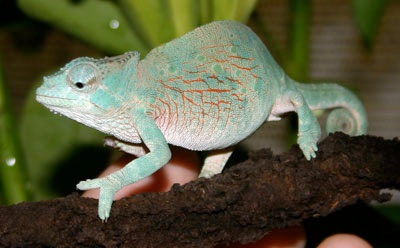
Adult female Chamaeleo (Trioceros) montium. Photo Courtesy of Chris Anderson
Similar Species
There are a few species that in some way could be confused with Ch. (T.) montium. These include: Ch. (T.) camerunensis, Ch. (T.) pfefferi (Pfeffer's Chameleon), Ch. (T.) cristatus (Crested Chameleon), Ch. (T.) feae (Fe's Chameleon), Ch. (T.) wiedersheimi (Mt. Lefo's or Peacock Chameleon), Ch. (T.) quadricornis (Four-horned Chameleon), and Ch. (T.) balebicornutus.

Chamaeleo (Trioceros) quadricornis. Photo Courtesy of Leah Kroo
Ch. (T.) quadricornis are similar to Ch. (T.) montium due to their dorsal crest, sailfin, and casque lacking a parietal crest. Ch. (T.) quadricornis, however, have distinct gular and ventral crests consisting of enlarged conical scales. Additionally, Ch. (T.) quadricornis is generally larger than Ch. (T.) montium with males reaching 15 inches (38cm) total length and females reaching 12 inches (29cm) total length. While the number of rostral horns in Ch. (T.) quadricornis varies, the horns are generally relatively shorter than those of Ch. (T.) montium and slightly upturned as opposed to generally sticking straight forward. While also a Cameroon native like Ch. (T.) montium, Ch. (T.) quadricornis also lives in Nigeria.
Ch. (T.) balebicornutus can be differentiated from Ch. (T.) montium in a combination of ways. To start with, Ch. (T.) balebicornutus is found only in Ethiopia while Ch. (T.) montium is only found in Cameroon. Secondly, the two rostral horns of Ch. (T.) balebicornutus are more similar to those of Ch. (T.) quadricornis than those of Ch. (T.) montium. Finally, Ch. (T.) balebicornutus have dorsal, gular, and ventral crests made up of well-defined conical scales.
Ch. (T.) cristatus are similar to Ch. (T.) montium by their high sail-like ridge of a dorsal crest, lack of gular or ventral crests and flat casque. The casque of Ch. (T.) montium, however, is taller and the scalation of Ch. (T.) cristatus is entirely homogeneous, lacking the plate-like scales on the flanks and head of Ch. (T.) montium. Additionally, the interstitial skin of the gular pouch tends to be red-as opposed to white-in Ch. (T.) montium. Ch. (T.) cristatus can be found in Cameroon, Gabon, Ghana, Congo, Equatorial Guinea, Togo, Fernando Po Island, and the Central African Republic.
Ch. (T.) wiedersheimi have a flat casque and a similar dorsal crest to that of Ch. (T.) montium. From Cameroon and Nigeria, this species has both gular and ventral crests formed from conical scales that Ch. (T.) montium lack. Furthermore, Ch. (T.) wiedersheimi have a single row of enlarged scales running down the body high on the flanks rather than the numerous randomly placed disk-like scales of Ch. (T.) montium.
Ch. (T.) camerunensis lacks a gular or ventral crest and has a scalloped dorsal crest like Ch. (T.) montium. Endemic to Cameroon, the best differentiating feature of this species is that unlike the rest of the mentioned species, rather than a flat casque, this species' casque is convex.
Ch. (T.) pfefferi is a rarer Cameroonian species with similar rostral horns and casque to Ch. (T.) montium. This species, however, has a dorsal crest of denticulate (triangular tooth-like) and conical scales, often extending onto the tail in males, and a prominent dorsal crest of 10-13 conical scales.
Probably the most similar species is Ch. (T.) feae. The males of this species lack horns but have two enlarged scales over the eyes. Furthermore, Ch. (T.) feae are only found on Fernando Poo Island of Equatorial Guinea.

Adult Male Chamaeleo (Trioceros) montium. Photo Courtesy of Robert Ossiboff
Trade Status
As a CITES Appendix II listed species, all international trade in Ch. (T.) montium is monitored and all international trade or transport across international borders require CITES permits. Currently, CITES has issued an annual export quota of 1500 live Ch. (T.) montium to be allowed for export from Cameroon. Technically, this is the only annual quota issued for Cameroonian chameleons although Ch. (T.) quadricornis, Ch. (T.) wiedersheimi, and Ch. (T.) cristatus do come into importers with varying consistency. Currently, the other mentioned species are rarely, if ever, available in captivity making identification of imported specimens fairly easy.
Habitat
Ch. (T.) montium lives in humid, mountainous cloud forests of Cameroon between 500-1200 meters elevation. Their habitat has generally moderate temperatures and relatively high humidity. Temperatures reach up to approximately 85F (30C) during the day and nighttime lows are known to reach 60F (15C). Relative humidity is generally between 80-100%. Rain is always present in some respect, even during the "dry seasons" and variation in the amount of rain throughout the year is common with two periods of both wet and "dry" seasons per year. Such annual variation in rain may be useful in attempts to stimulate captive breeding.
Acclimation
When acclimating any species of chameleon, it is important to attempt to imitate their wild environment as much as possible, this is no exception for Ch. (T.) montium. Cages should be planted quite heavily and have a large network of branches intertwined between them. One of the most important acclimation factors is privacy. This species will not behave normally when uncomfortable, and there is really no other way to accomplish this when the animal is constantly on display and vulnerable to "predation." Ch. (T.) montium most often shows shades of brown when stressed after importation, as well as having the dorsal crests bent, and damaged. Bent crests do not return to normal. As with the generalized care, this species is considered intermediate to advanced in the acclimation difficulty. The water requirements during acclimation are much higher given nearly all animals will be dehydrated initially and will need sufficient hydration levels before parasite treatments can take place. Showering every other day during the initial acclimation period is recommended, and intermittently thereafter for hydration maintenance.
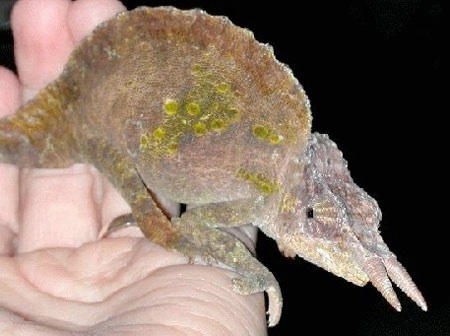
Adult male Chamaeleo (Trioceros) montium. Photo Courtesy of Leah Kroo
Captive Husbandry
This species is extremely shy and should be provided with a well-planted enclosure in a low-traffic area. Due to humidity requirements, screen or mesh enclosures are best in order to ensure proper air circulation and avoid stagnant air. Live plants are optimal and they provide the added benefit of naturally helping to increase and hold humidity. To help increase the amount of plant cover, pothos vines can be used and draped around the enclosure to decrease the amount of vacant space. A combination of vines, branches, and non toxic tropical flora are ideal. The denser the enclosure is, the more at home your montium will feel and the less skittish it will be. This will allow for much more viewing time, not to mention a more aesthetically rewarding enclosure. The authors have found that the dark mesh of Repteriums or having as many as 3 sides of the enclosure wood helps this species feel more secure and minimize stress. This species should be housed individually and does well in enclosures measuring 30" high x 18" x 18" (75cm x 45cm x 45cm) and larger.
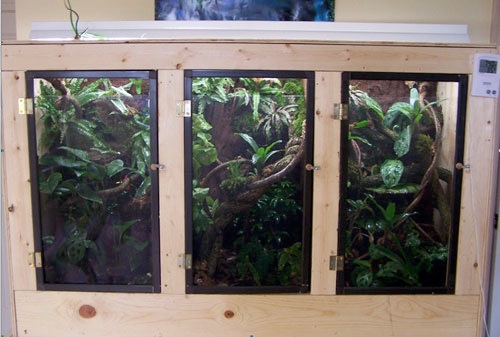
Suitable three-sided wood enclosure for Chamaeleo (Trioceros) montium Photo Courtesy of Mike Coraggio
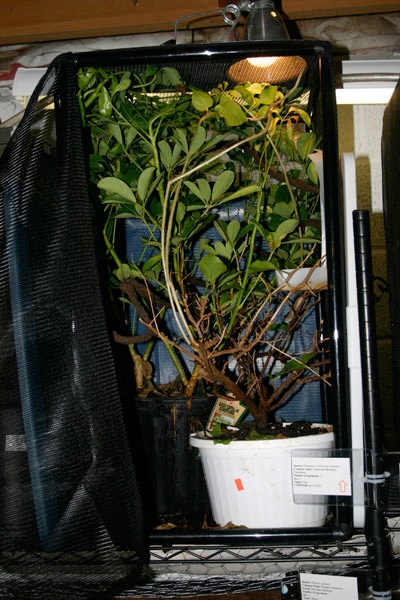
Suitable Chamaeleo (Trioceros) montium enclosure. Photo Courtesy of Chris Anderson
The enclosure should be well lit with fluorescent UVB tubes. The authors have found that the Reptisun 5.0 works quite effectively with this species and recommend against new higher radiance bulbs that combine heat and UVB radiation. This recommendation is due to the nature of their wild habitat, the delicate skin of chameleons in general relative to other, more desert reptiles and studies showing potentially deleterious effects of prolonged, forced high intensity UVB exposure to captive chameleons. In addition to UVB bulbs, a basking bulb is provided to allow for basking at temps marginally over 85F (30C) while the ambient temperature is maintained closer to 75F (24C). Under most circumstances, heating devices for night temperature control are not needed and even discouraged. Night temperatures can drop into the mid 50s (12C) without ill effects. Prolonged periods of excess heat exposure should be avoided but during these periods, increased humidity and hydration efforts should be provided.
Humidity should be kept relatively high. Misting two times a day for 20-30 minutes is generally sufficient for proper hydration. Less lengthy misting periods provided more frequently should also prove sufficient although misting durations should exceed 5 minutes per session to ensure proper drinking stimulation. Further, the enclosure should not be consistently wet and should be allowed to dry between misting sessions. If humidity in your area is difficult to maintain, a humidifier may be used. Due to the shy nature of this species, the authors have found the use of an automatic misting system to be extremely beneficial as it provides a consistent watering regime without the stress of external influences which can potentially alter an animal's willingness to drink.
Ch. (T.) montium are susceptible to over-supplementation and as a result, supplements should be used sparingly. A healthy gutload for feeders is recommended as the optimum means for providing the majority of these vitamins and minerals. This species is generally good at accepting a wide range of feeders and a variety should be supplied. Ch. (T.) montium are extremely susceptible to hypervitaminosis A. Great care must be taken to provide necessary vitamin supplementation without overdosing on vitamin A. Vitamin in the form of beta carotene can be broken down much more rapidly and thus is more suitable for providing this species with its Vitamin A requirement. A good supplementation is Rep-Cal "Herptivite" and Rep-cal "Calcium with VIT.D3." The authors dust with Herptivite twice a week and Calcium three times a week with good success. Growing montium or gravid females can receive dusting 3 times a week for both supplements.
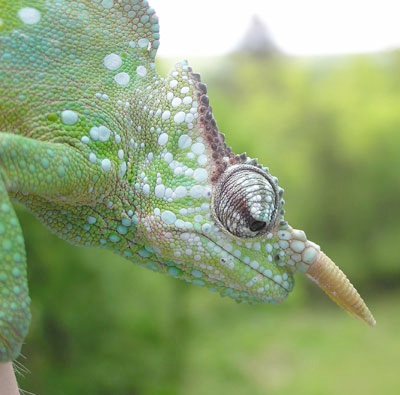
Adult Male Chamaeleo (Trioceros) montium. Photo Courtesy of Robert Ossiboff
Reproduction, Incubation and Neonatal Care
In the wild, breeding generally occurs in the wet season. By varying the intensity of misting throughout the year, it may be possible to simulate a rainy season and thereby stimulate breeding behavior. That said, however, this species seems to breed even in the absence of such intentional misting variation. Further, it is believed that this species is able to retain sperm allowing for fertilization at a later date. Generally, clutch size is positively correlated with the size of the female while this correlation for some other species, like Chamaeleo (T.) hoehnelii is generally negative.
Gestation in captivity is approximately two months. The female lays a clutch with an average of 5-12 eggs (clutches of 3-18 have been recorded) relatively large eggs and are often not very picky about their oviposition site, laying the eggs a few inches under a laying substrate and covering them afterward. Eggs hatch after a period of 4-6 months when incubated in the low to mid 70sF (21-24C) with a slight night temperature drop. The authors have had the best success with incubation on the lower side of this spectrum. Incubation, however, has been successful at temperatures as high as the mid 80sF (30C) although the authors recommend lower incubation temperatures as they tend to yield stronger babies in most species.
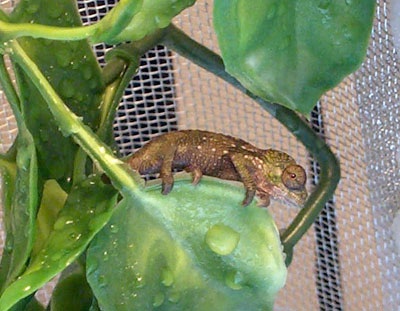
Neonate Chamaeleo (Trioceros) montium. Photo Courtesy of "Roo"
Neonates can be kept in simple baby rearing enclosures of various types. They should be provided with Fruit Flies and other small prey items for food. Humidity should be maintained at relatively high levels. It is extremely important to remember that ventilation is key as well. The authors raise baby montium in 10-gallon enclosures with a screen top. Computer fans are overhead to circulate air. The babies are particularly susceptible to fungal and bacterial infections so air flow is paramount. This species matures quickly with reproduction possible in the first year (sexual maturity at as young as 6 months old). In the wild, females as small as 2.5 inches (6.5 cm) snout to vent length have been known to drop clutches although it is not recommended to breed females until they are larger.
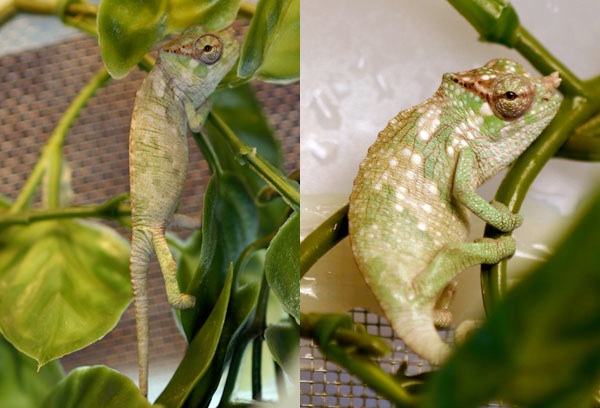
Juvenile male Chamaeleo (Trioceros) montium. Photos Courtesy of Chris Anderson
Conclusion
The Cameroon Mountain Two-horned Chameleon, Chamaeleo (Trioceros) montium, is a very rewarding and beautiful species. While often available at relatively low costs, their care requirements are specific and not what one should consider easy. As a result, the authors recommend this species for experienced chameleon keepers looking to experience some of the more delicate montane species. When properly acclimated, dewormed and maintained, this species make wonderful, albeit shy captives which we have truly enjoyed working with. We hope that captive success with this species will continue to grow.
References:
Davison, Linda J. (1997). Chameleons: Their Care and Breeding. Hancock House Publishers, WA.
Export quotas for specimens of species included in the CITES Appendices for 2005 - http://cites.org/common/quotas/2005/quotas2005.pdf (Accessed May 14, 2005).
Herrmann, Patricia & Hans-Werner Herrmann (2005). Egg and Clutch Characteristics of the Mountain Chameleon, Chamaeleo montium, in Southwestern Cameroon. Journal of Herpetology, Vol. 39, No. 1: 154-157.
Klaver, Charles & Wolfgang Böhme (1997). Das Tierreich: Teilband 112-Chamaeleonidae. Walter de Gruyter & Co., Berlin.
Necas, Petr. Chameleons of the Subgenus Trioceros Swainson, 1839. Reptilia Number 24: 10-29.
Necas, Petr (2004). Chameleons: Nature's Hidden Jewels. 2nd Edition. Chimaira Buchhandelsgesellschaft, Germany.
Schuetze, Tim (1998). Chameleon Profile: Chamaeleo (Trioceros) pfefferi. The CHAMELEON information Network 30: 14-19.

Christopher V. Anderson
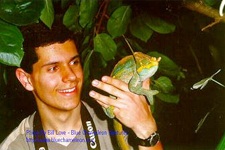
Chris Anderson is a herpetologist currently working on his Ph.D. at the University of South Florida after receiving his B.S. from Cornell University. He has spent time in the jungles of South East Asia, among other areas, aiding in research for publication. He has previously traveled throughout Madagascar in search of, and conducting personal research on, the chameleons of the region. He has traveled to over 35 countries, including chameleon habitat in 6. Currently, Chris is the Editor and Webmaster of the Chameleons! Online E-Zine and is studying the kinematics and morphological basis of ballistic tongue projection and tongue retraction in chameleons for his dissertation. Chris Can be emailed at Chris.Anderson@chameleonnews.com or cvanders@mail.usf.edu.

Mike Coraggio

Mike's infatuation with chameleons began in 1995 with his first chameleon handbook and amplified only with reading. His interests in chameleons only continue to grow. Some of his chameleon research includes field studies on Hawaiian Jackson chameleon populations in Maui and publication involving caesarian sections performed on eggbound Furcifer pardalis. He has experience with the husbandry and reproduction of 23 chameleon species. Current breeding interests are concentrated on the rainforest chameleon species of Cameroon and Tanzania. In his spare time, Mike enjoy countless hours of college work-just kidding! He is a student at Rutgers University finishing up his BS in Landscape Architecture. His love for chameleons is only matched by my love for the outdoors, traveling, and working with poison dart frogs. You can reach Mike at macswatergardens@hotmail.com.

Leah Kroo

Leah Kroo has been working with reptiles since 1996. She started with chameleons and has captive bred over 10 species, and kept many others. Currently, she is working with C. quadricornis. Leah also keeps a wide variety of geckos, primarily Rhacodactylus and Uroplatus species, and is breeding various insects from exotic praying mantids to beetles. You can contact her at sales@wildeyereptiles.com, or www.wildeyereptiles.com.









Join Our Facebook Page for Updates on New Issues:
© 2002-2014 Chameleonnews.com All rights reserved.
Reproduction in whole or part expressly forbidden without permission from the publisher. For permission, please contact the editor at editor@chameleonnews.com
